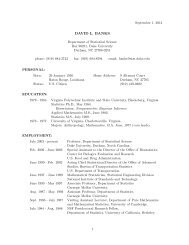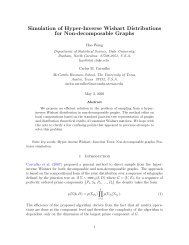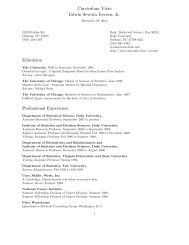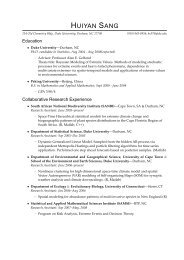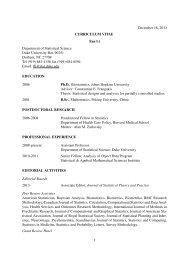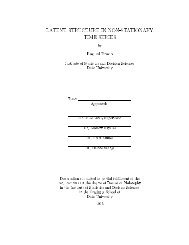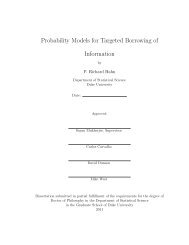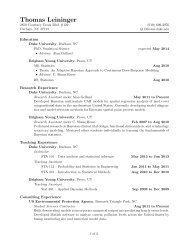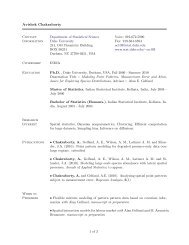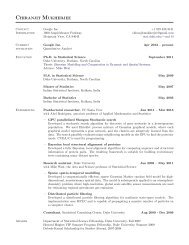Bayesian Inference in Cyclical Component Dynamic Linear Models
Bayesian Inference in Cyclical Component Dynamic Linear Models
Bayesian Inference in Cyclical Component Dynamic Linear Models
You also want an ePaper? Increase the reach of your titles
YUMPU automatically turns print PDFs into web optimized ePapers that Google loves.
<strong>Bayesian</strong> <strong>Inference</strong> <strong>in</strong> <strong>Cyclical</strong> <strong>Component</strong><br />
<strong>Dynamic</strong> L<strong>in</strong>ear <strong>Models</strong><br />
Mike WEST<br />
<strong>Dynamic</strong> l<strong>in</strong>ear models (DLM's) with time-vary<strong>in</strong>g cyclical components are developed for the analysis of time series with persistent<br />
though time-vary<strong>in</strong>g cyclical behavior. The development covers <strong>in</strong>ference on wavelengths of possibly several persistent cycles <strong>in</strong><br />
nonstationary time series, permitt<strong>in</strong>g explicit time variation <strong>in</strong> amplitudes and phases of component waveforms, decomposition of<br />
stochastic <strong>in</strong>puts <strong>in</strong>to purely observational noise and <strong>in</strong>novations that impact on the waveform characteristics, with extensions to<br />
<strong>in</strong>corporate ranges of (time-vary<strong>in</strong>g) time series and regression terms wih<strong>in</strong> the standard DLM context. <strong>Bayesian</strong> <strong>in</strong>ference via<br />
iterative stochastic simulation methods is developed and illustrated. Some <strong>in</strong>dications of model extensions and generalizations are<br />
given. In addition to the specific focus on cyclical component models, the development provides the basis for <strong>Bayesian</strong> <strong>in</strong>ference,<br />
via stochastic simulation, for state evolution matrix parameters and variance components <strong>in</strong> DLM's, build<strong>in</strong>g on recent work on<br />
Gibbs sampl<strong>in</strong>g for state vectors <strong>in</strong> such models by other authors.<br />
KEY WORDS: Autoregressive component dynamic l<strong>in</strong>ear model; <strong>Cyclical</strong> time series; <strong>Dynamic</strong> l<strong>in</strong>ear model; Markov cha<strong>in</strong><br />
Monte Carlo.<br />
1. INTRODUCTION<br />
Applications of traditional dynamic l<strong>in</strong>ear models<br />
(DLM's), or state-space models, with cyclical components<br />
have to date been broadly restricted to contexts <strong>in</strong> which<br />
periods of cyclical components are known and <strong>in</strong>teger, the<br />
typical contexts of seasonal model<strong>in</strong>g and time-vary<strong>in</strong>g harmonic<br />
analysis (West and Harrison 1989, chap. 8). Problems<br />
of <strong>in</strong>ference about uncerta<strong>in</strong> wavelengths of timevary<strong>in</strong>g<br />
cyclical components <strong>in</strong> such models have been untouched,<br />
<strong>in</strong> part due to analytic complications. This article<br />
beg<strong>in</strong>s to address such problems.<br />
Consider a real-valued, zero-mean time series Yt observed<br />
at times t = 1, 2, ... We deal with models of the form<br />
k<br />
Yt =Xt,0 + E Xt,j + vt, 1<br />
j=1<br />
where the k dist<strong>in</strong>ct, latent processes Xt,j, t - 1, 2,...,<br />
represent persistent periodic components of dist<strong>in</strong>ct frequencies<br />
and with, quite generally, possibly time-vary<strong>in</strong>g<br />
amplitude and phase characteristics. The component xt,0<br />
represents additional time series structure, <strong>in</strong>clud<strong>in</strong>g possibly<br />
nonstationary trend or growth and regression effects,<br />
and vt represents observation noise, typically comb<strong>in</strong><strong>in</strong>g<br />
measurement, sampl<strong>in</strong>g, and residual misspecification errors.<br />
Our <strong>in</strong>terest lies specifically <strong>in</strong> models <strong>in</strong> which each<br />
of the cyclical processes has the form xt,j = rjtcos(atjt<br />
+ qjt), a s<strong>in</strong>usoid of fixed period Aj = 27r/aj, and stochastically<br />
time-vary<strong>in</strong>g amplitude ajt and phase bjt. We are <strong>in</strong>terested<br />
<strong>in</strong> <strong>in</strong>ference for the entire model to identify acyclic<br />
trends and, simultaneously, the wavelengths Aj and the patterns<br />
of behavior of the cyclical subseries xt,j over the period<br />
of the observed data. One applied focus for such models<br />
is <strong>in</strong> evaluat<strong>in</strong>g trends <strong>in</strong> the presence of periodicities of<br />
uncerta<strong>in</strong> wavelengths; another, more usual context is when<br />
<strong>in</strong>terest lies <strong>in</strong> identify<strong>in</strong>g persistent subcycles, possibly of<br />
generally low amplitude, <strong>in</strong> noisy series. The latter problem<br />
is typified by climatological studies <strong>in</strong> which the existence<br />
of subtle periodic components may <strong>in</strong>fluence discussions of<br />
global climate change (see, for example, West 1995).<br />
A complete model specification requires descriptions of<br />
the precise forms of time-variation anticipated <strong>in</strong> amplitudes<br />
and phases, and that is done here through the use of<br />
cyclical form DLM's (West and Harrison 1989, chap. 8<br />
and sec. 9.4). These models provide generalizations and<br />
alternatives to more traditional parametric models, such as<br />
harmonic regression (Bretthorst 1988) and stationary models,<br />
with features common to all state-space models. In<br />
particular, the key issue of time variation <strong>in</strong> cyclical components<br />
naturally extends traditional harmonic regression<br />
models. DLM's explicitly partition of sources of variation<br />
<strong>in</strong>to purely observation noise versus noise components affect<strong>in</strong>g<br />
signals, cyclical or otherwise. Thus the signals xt,j<br />
have characteristics that change over time, to a greater or<br />
lesser extent, and these changes are determ<strong>in</strong>ed by noise<br />
terms identified and dist<strong>in</strong>ct from the noise terms vt that affect<br />
only the observations. In some problems, measurement<br />
and sampl<strong>in</strong>g errors and possible additive outliers account<br />
for a major component of observed data variation, and so<br />
this explicit representation, which is absent from traditional<br />
stationary time series models, is critical. Potential future<br />
extensions to model outliers and abrupt changes <strong>in</strong> signal<br />
form can build on exist<strong>in</strong>g model<strong>in</strong>g and <strong>in</strong>tervention ideas<br />
<strong>in</strong> DLM's (West and Harrison, chaps. 10 and 11). Further,<br />
DLM representations allow for rout<strong>in</strong>e handl<strong>in</strong>g of miss<strong>in</strong>g<br />
values and irregularly spaced data <strong>in</strong> time series (West<br />
and Harrison, sec. 10.5), <strong>in</strong> contrast to standard stationary<br />
time series and spectral methods. Moreover, the models <strong>in</strong>clude<br />
traditional harmonic regressions (Bretthorst 1988) as<br />
special cases, and so provide for the assessment of stable<br />
cyclical forms with<strong>in</strong> the more general dynamic framework,<br />
and computational tools to fit essentially constant harmonic<br />
components.<br />
Mike West is Professor and Director, Institute of Statistics and Decision<br />
Sciences, Duke University, Durham, NC 27708-0251. Partial support for<br />
this work was provided by National Science Foundation Grants DMS-<br />
9024792 and DMS-9311071.<br />
1301<br />
? 1995 American Statistical Association<br />
Journal of the American Statistical Association<br />
December 1995, Vol. 90, No. 432, Theory and Methods
1302 Journal of the American Statistical Association, December 1995<br />
45 -<br />
sov<br />
40-<br />
.50<br />
100<br />
.150<br />
35 -<br />
30 -<br />
25-<br />
20-<br />
-200<br />
0 20 40 60 80 100<br />
time<br />
Figure 1. 1 10 Observations on an EEG Trace.<br />
Figure 2.<br />
5 10 15<br />
wavelength<br />
Smoothed Periodogram for the Detrended EEG Time Series.<br />
In addition to the specific focus on cyclical component<br />
models, this article develops, for the first time, simulation<br />
analyses for state evolution matrix parameters and variance<br />
components <strong>in</strong> DLM's. This builds on and extends recent<br />
work on Gibbs sampl<strong>in</strong>g and related methods for posterior<br />
distributions for state vectors themselves (Carter and<br />
Kohn 1993; Fruhwirth-Schnatter 1994) and provides the<br />
basis for wider application of state-space models with uncerta<strong>in</strong><br />
def<strong>in</strong><strong>in</strong>g evolution and variance parameters, <strong>in</strong> some<br />
generality.<br />
2. DYNAMIC LINEAR MODEL AUTOREGRESSIONS<br />
2.1 Basic Model Structure Us<strong>in</strong>g <strong>Cyclical</strong><br />
Autoregressive <strong>Component</strong> <strong>Dynamic</strong> L<strong>in</strong>ear <strong>Models</strong><br />
Of the several possible representations of time-vary<strong>in</strong>g<br />
cycles, the simple cyclical autoregressive form (West and<br />
Harrison 1989, sec. 9.4) is the focus here, for reasons that<br />
will become apparent. Consider each of the latent model<br />
components xt,j <strong>in</strong> (1). The basic representation of <strong>in</strong>terest<br />
is<br />
= a,jcos(27rt/Aj + b,ij), where Aj = 27r/acos(C3/2), or<br />
Ij = 2cos(27r/Aj) = 2cos(aj), and the amplitude al,j and<br />
phase bl,j are constants determ<strong>in</strong>ed by the start<strong>in</strong>g value<br />
zij, and /3j. Thus we have a model component def<strong>in</strong><strong>in</strong>g a<br />
cyclical process of constant period Aj. Over time, the <strong>in</strong>novations<br />
w,j impact the process, <strong>in</strong>duc<strong>in</strong>g stochastic time<br />
variation <strong>in</strong> the amplitude and phase characteristics, with<br />
such variations related directly to the <strong>in</strong>novations variance<br />
wj (Priestley 1981, sec. 3.5.3; West and Harrison 1989,<br />
p. 253).<br />
Thus (1) and (2) comb<strong>in</strong>e to give the overall model<br />
10 -<br />
Yt =Xt,0 + E xt,j + vt<br />
j=1<br />
k<br />
Xtj = jXt1 -,j - Xt-2,j + Wtj (2)<br />
where /j is a model parameter to be discussed later and<br />
w,j is an <strong>in</strong>novation term at time t. As usual <strong>in</strong> dynamic<br />
l<strong>in</strong>ear model<strong>in</strong>g, the w,j, (t = 1, 2, .. .), are assumed to<br />
be <strong>in</strong>dependent and mutually <strong>in</strong>dependent sequences, with<br />
Wt,j -N(tj w IO, jw).<br />
This model for xt,j is a standard AR(2) form with a statespace<br />
representation (West and Harrison 1989, sec. 9.4),<br />
Xt,j = (1, O)zt,j and Zt, = Gjztl,3 + (t,j, 0)'<br />
where Zt, = (xt,j, Xti,j)' for all t. Conditional on (an arbitrary<br />
start<strong>in</strong>g value) z1,j, the implied forecast function for<br />
the future of the process is E(x+,;Iz,i) = (l,O)Gt-1z, ,<br />
and this has a form, as a function of t, determ<strong>in</strong>ed by the<br />
eigenstructure of Gj us<strong>in</strong>g standard theory (West and Harrison<br />
1989, chap. 5). It easily follows that E(xt,j|Zi,;)<br />
8 s<br />
0)<br />
0J<br />
0<br />
5 10 15 20<br />
wavelength<br />
Figure 3. <strong>Bayesian</strong> "Periodogram" for the EEG Series, Based on the<br />
Simple Harmonic Regression Model with a S<strong>in</strong>gle Cycle, Follow<strong>in</strong>g Bretthorst<br />
(1988). The plotted curve is the log-likelihood function, equivalently<br />
the reference posterior density under a uniform prior, for the<br />
s<strong>in</strong>gle wavelength <strong>in</strong> such a model.
West: <strong>Inference</strong> on Cycles <strong>in</strong> Time Series 1303<br />
and<br />
Xt,; =3jXt-1,j -Xt-2,j + Wtj (j 1, , k), (3)<br />
100 -<br />
so - ++ +<br />
with /3 = 2 cos(27r/Aj) for j = ,... , k. In addition to<br />
the earlier assumptions about the <strong>in</strong>novations process, it<br />
is further assumed that the observational errors form an<br />
<strong>in</strong>dependent sequence and are <strong>in</strong>dependent of the Wt,j, with<br />
Vt N(vtIO,v).<br />
It rema<strong>in</strong>s to model the acyclic trend process xt,0. To<br />
take a simple and specific model, though one of much utility<br />
and used <strong>in</strong> an illustration that follows, we suppose here<br />
a first-order polynomial. Other DLM forms are possible,<br />
of course, but the first-order model provides for simple but<br />
flexible local smooth<strong>in</strong>g of underly<strong>in</strong>g, acyclical, and nonstationary<br />
trends <strong>in</strong> the absence of more <strong>in</strong>formed trend<br />
models such as regression DLM's. Then (follow<strong>in</strong>g West<br />
and Harrison 1989, chap. 2),<br />
Xt,O = Xt-1,0 + W'tO,<br />
where wt,O N(w)t,o 0, wo) <strong>in</strong>dependently over time and <strong>in</strong>dependently<br />
of the <strong>in</strong>novations wtj <strong>in</strong> (3). This trend model<br />
comb<strong>in</strong>es with (3) to give the general DLM representation<br />
and<br />
Yt = F'zt + Vt<br />
with the follow<strong>in</strong>g <strong>in</strong>gredients:<br />
Zt = Gzt_l + 6t, (4)<br />
Xt,O 1<br />
Xt,1<br />
Xt,21<br />
Zt= St12 F= 0<br />
Xt,k 1<br />
Xt-l,k 0<br />
/1<br />
:1 -1<br />
1 0<br />
/32 1<br />
G= 1 0<br />
50 + + +<br />
-200 + + ++<br />
l<br />
40 o 2<br />
6<br />
>0 ~~~~~~ +<br />
Lmt +<br />
+~~~ 4k<br />
Here - is+ b so t +<br />
-200 ~ ~ ~ ~ + + +<br />
0 20 40 60 80 100<br />
-100<br />
vaiac mari W igw;w ;W,0 N . ***<br />
)<br />
time<br />
Figure 4. Estimated Acyctlc Trend, With One Standard Deviation<br />
Limits, for the EEG Series.<br />
Here G is block-diagonal, so the "empty" entries <strong>in</strong> (5)<br />
are all zero. Note further that 6t -N (6t 0O, W) with diagonal<br />
variance matrix W = diag(wo; wl, 0; W2, o; ... ; Wk, 0).<br />
2.2 Posterior Structure and Framework of Simulation<br />
Analysis<br />
Assume the model (4) for the series of n observations<br />
{Yt; t = 1, ... , n}. <strong>Inference</strong> is required on the wavelengths<br />
A, equivalently the state parameters 3 = {i3,- ... , !k },<br />
the variance components v and W, the <strong>in</strong>dividual "latent"<br />
stochastic subcycles Xj d {xt,j; t = O.... ,n} for each<br />
j = 1,...,k, and the trend component Xo df {Xt,o; t<br />
= O,... ,}. In standard notation, def<strong>in</strong>e Dt = {yt, Dt-i}<br />
for the <strong>in</strong>formation set available at time t, hav<strong>in</strong>g observed<br />
the time series value at that time; at t = 0, Do represents<br />
all <strong>in</strong>itial <strong>in</strong>formation <strong>in</strong>clud<strong>in</strong>g the model specification and<br />
assumptions. Assume the analysis to be closed to external<br />
<strong>in</strong>puts and <strong>in</strong>terventions, so that Dt is a sufficient summary<br />
of the history at time t. Hence analysis <strong>in</strong>volves specify<strong>in</strong>g<br />
100<br />
50 -<br />
0<br />
4<br />
Wt ,O<br />
Wt, 1<br />
0<br />
wt,2<br />
nt ,k<br />
/3k -1<br />
1 0<br />
t= 0' 5<br />
0<br />
-50<br />
-150 -'<br />
-200 -<br />
., , , , I<br />
0 20 40 60 80 100<br />
time<br />
Figure 5. Fitted Values for the EEG Series.
1304 Journal of the American Statistical Association, December 1995<br />
(0<br />
150<br />
100<br />
50<br />
-50-<br />
-100 -<br />
-150 -<br />
r I I<br />
0 20 40 60 80 100<br />
time<br />
Figure 6. Estimated Residuals From the EEG Data Analysis.<br />
classes of priors for {/3, v, W, zo}, then comput<strong>in</strong>g posterior<br />
distributions and appropriate summaries for {/3, v, W, Z},<br />
where Z is the complete set of state variables,<br />
def<br />
Analyses here are based on priors of the form<br />
p(A, v, W, zo) = p(O)p(V)p(zo)<br />
k<br />
fi p(Wj),<br />
j=O<br />
where p(.) is generic notation for density function. Extensions<br />
to <strong>in</strong>corporate further prior dependencies are possible.<br />
On this basis, the follow<strong>in</strong>g structure may be deduced:<br />
1. Assume that /, v, and W are specified. Then (4) is<br />
a standard normal DLM whose analysis is fully def<strong>in</strong>ed <strong>in</strong><br />
closed analytic form (West and Harrison 1989, chap. 4) if<br />
it is assumed that the prior for the <strong>in</strong>itial state vector zo is<br />
a specified normal distribution, zo N(zo I0m, CO). Note<br />
that this prior may depend on the condition<strong>in</strong>g values of<br />
/, v, and W, though this is of little practical relevance, and<br />
so no such dependence is assumed throughout. Standard<br />
updat<strong>in</strong>g results (West and Harrison 1989, sec. 4.3) apply to<br />
sequentially compute moments mt and Ct of the posterior<br />
normal distributions for (ztlDt) at all times t. Because the<br />
values of /, v, and W are conditioned on, make this explicit<br />
<strong>in</strong> the notation; thus it is simple to compute the moments<br />
def<strong>in</strong><strong>in</strong>g the "on-l<strong>in</strong>e" posteriors,<br />
(zt Dt, /, v, W) - N(ztImt, Ct), (t = 1, ... , n). (6)<br />
2. Assume the complete set of subseries Z = {Xo,<br />
X1, . .., Xk} to be specified <strong>in</strong> addition to /, and focus on<br />
<strong>in</strong>ference about the variance components v and W. Under<br />
the assumed conditionally <strong>in</strong>dependent prior,<br />
with the follow<strong>in</strong>g components:<br />
(a) p(vID7, Z) oC p(v)v-n/2exp(-s/(2v)), where s<br />
- i=i(ytt-F'zt)2;<br />
(b) p(woIXo) CX p(wo)w-n/2exp(-ro/(2wo)), where<br />
ro = Z -i(xt,O-xt_1,0)2; and<br />
(c) for each j = 1,.. ,k, p(wj lof, Xj) oc p(wj)wf(n 1)/2<br />
x exp(-rj/(2wj)), and with sum of squares rj<br />
Zt=2(xt,j - /jXtl,j + Xt2,J).<br />
It is evident that <strong>in</strong>dependent <strong>in</strong>verse gamma priors for<br />
all k + 2 scalar variance components here are conditionally<br />
conjugate, the sets of posteriors described then be<strong>in</strong>g <strong>in</strong>verse<br />
gamma forms with updated shape and scale parameters<br />
<strong>in</strong> each case. Other priors may be used. One recommended<br />
alternative is rather un<strong>in</strong>formative priors <strong>in</strong> which<br />
the standard deviations ar and wj for each j are assumed<br />
to be uniformly distributed over f<strong>in</strong>ite and specified<br />
ranges. Then the forego<strong>in</strong>g conditional posteriors are truncated<br />
gamma distributions.<br />
3. Assume the complete set of subseries Z = {Xo,<br />
Xl, . ..., Xk } to be specified <strong>in</strong> addition to the variance components<br />
v and W, and focus on <strong>in</strong>ference about 3. For each<br />
j 1, ..., k, def<strong>in</strong>e scalar quantities bj and Bj by<br />
B7 I=<br />
Then<br />
n<br />
n<br />
X2<br />
1j and bj = Bj Z(xt,J + xt2,J)xt1,J<br />
t=2 t=2<br />
p(lDn7,v,W,Z) p(f3W, Z)<br />
k<br />
O? p(f) 11 exp(-(j -bj)2/(2Bjwj))<br />
j=1<br />
It is now easy to see that simulation-based analysis us<strong>in</strong>g<br />
Markov cha<strong>in</strong> Monte Carlo is straightforward to implement.<br />
Iterative sampl<strong>in</strong>g of conditional posterior distributions de-<br />
150 l<br />
100 -<br />
50-<br />
-50-<br />
-100 -<br />
-150<br />
0 20 40 60 80 100<br />
(8)<br />
k<br />
= p(v |Dn:Z)p(wo ]Xo )flp(wj l/3i,Xj ), (7)<br />
j=1<br />
time<br />
Figure 7. Estimated Trajectory Over Time, With Uncerta<strong>in</strong>ty Bands,<br />
for the First <strong>Cyclical</strong> <strong>Component</strong> of a Two-Cycle Model for the EEG<br />
Series.
West: <strong>Inference</strong> on Cycles <strong>in</strong> Time Series 1305<br />
150 -<br />
100<br />
50~~~~~~~~~~~~~~~~~~~~~~~~~~~~~<br />
-<br />
50<br />
-50 -<br />
-100<br />
-150<br />
This produces a sequence ZnZn- . ....I ZO, equivalently the<br />
set Z, as required. The computations are quite straightforward<br />
when it is recognized that on the basis of the strong<br />
conditional <strong>in</strong>dependence structure <strong>in</strong> the model (4),<br />
p(zt IDn , OiV- W, Zt+1 I Zt+2, I ,.<br />
Zn)<br />
-- p(ztlDn, ,B, vI WI Zt+1).<br />
Furthermore, comb<strong>in</strong><strong>in</strong>g the second equation <strong>in</strong> (4) with<br />
the on-l<strong>in</strong>e posterior <strong>in</strong> (6) leads to<br />
p(ztJDn,/ ,Vt, WI Zt+l) x N(ztlmt, Ct)N(zt+I IGzt, W),<br />
0 20 40 60 80 100<br />
time<br />
Figure 8. Estimated Trajectory Over Time, With Uncerta<strong>in</strong>ty Bands,<br />
for the Second <strong>Cyclical</strong> <strong>Component</strong> of a Two-Cycle Model for the EEG<br />
Series.<br />
f<strong>in</strong>ed earlier may proceed by sampl<strong>in</strong>g through the sequence<br />
*>p(ZIDni/,B,V,W)<br />
k<br />
> p(v Dn,Z)p(wo X0) flp(Wj li0Xj )<br />
j=1<br />
---- > pP IW , Z) ---- > ... (9)<br />
at each iteration.<br />
The second stage here requires little further comment;<br />
the conditional posteriors for all variance components are<br />
outl<strong>in</strong>ed under Step 2. Steps 1 and 3 are considered <strong>in</strong> more<br />
detail <strong>in</strong> the next two sections. Before proceed<strong>in</strong>g, note that<br />
(as <strong>in</strong> Carter and Kohn 1994 and Friihwirth-Schnatter 1994),<br />
successive draws under this simulation scheme will eventually<br />
resemble draws from the full jo<strong>in</strong>t posterior distribution<br />
for {B3, v, W, Z}. The very general results provided by<br />
Smith and Roberts (1993, thm. 1 and lem. 1 of appendix),<br />
for example, are applicable.<br />
2.3 Simulation of Model <strong>Component</strong> Subseries<br />
The first stage of each simulation iteration (9) <strong>in</strong>volves<br />
sampl<strong>in</strong>g the conditional posterior of the full set Z of subseries,<br />
p(Z IDn, 3, v, W). Recent work by Carter and Kohn<br />
(1993) and Fruhwirth-Schnatter (1994) provides the basis<br />
for this step; earlier ideas appear <strong>in</strong> work of Carl<strong>in</strong>, Polson,<br />
and Stoffer (1992), though the specific algorithms of the<br />
first two references are more appropriate, as was made explicit<br />
by Carter and Kohn. A value of Z = {zo, . . ., Zn } may<br />
be drawn from the rather complicated and high-dimensional<br />
full posterior p(Z Dt, 13, v, W) as follows:<br />
* Simulate a value of Zn from (ZnlDn,/ y3 v, W)<br />
N (Zn Imn, Cn), simply (6) at t - n.<br />
* For each t = n - I,n - 2, .0. I, O reduc<strong>in</strong>g<br />
the time <strong>in</strong>dex by one at each step, simulate<br />
a value of Zt from the conditional posterior<br />
p(zt Dr,, 43, V, W, zt+, Zt+2 ... ,: Zn); at each stage the<br />
condition<strong>in</strong>g values of znr,zn-,... here are those<br />
just generated.<br />
(10)<br />
so that p(zt IDn, ,3, v, W, Zt+1) is normal with moments easily<br />
found; <strong>in</strong> detail, the mean and variance matrix are<br />
mt + At(zt+l - Gmt) and Ct - AtQtA', where Qt<br />
GCtG' + W and At = CtGQT1. This normal distribution<br />
is easily sampled, and then sequenc<strong>in</strong>g down<br />
through t n- ,n - 2,...,0 produces a full draw,<br />
Z { Zn ZO} as required. Further details have been<br />
given by Carter and Kohn (1994) and Fruhwirth-Schnatter<br />
(1994).<br />
A slight modification of the forego<strong>in</strong>g development that<br />
produces a more easily implemented algorithm <strong>in</strong>volves<br />
simulat<strong>in</strong>g Z by draw<strong>in</strong>g each of the model component subseries<br />
sequentially conditional on values of the other sub-<br />
series. Specifically, for each j 0, . . . k, <strong>in</strong>troduce Z()<br />
= Z\Xj, the set Z with Xj= {xj,o,...,x3,n} removed;<br />
write J for the correspond<strong>in</strong>g <strong>in</strong>dex set J = {O,...,j<br />
- 1, j + 1, ..., k}. Fix the <strong>in</strong>dex j and suppose that<br />
Z() is set at the previously sampled values. Compute the<br />
adjusted time series values Yt,j = Yt - >hCJ<br />
Xt,h, and write<br />
Zt,; = (Xt,j, Xt- ,j) for all t. Then, based on a previously<br />
simulated full set of subseries Z, a new set is generated by<br />
the follow<strong>in</strong>g procedure:<br />
4 -<br />
3 -<br />
2 -<br />
o J<br />
.M1ti,g ...<br />
5.5 6.0 6.5 7.0<br />
wavelength 1<br />
Figure 9. Approximate Posterior Density for the Smaller of the Two<br />
Wavelengths <strong>in</strong> the Two-<strong>Component</strong> Model for the EEG Series.
1306 Journal of the American Statistical Association, December 1995<br />
Now the forego<strong>in</strong>g development <strong>in</strong> terms of the full<br />
0.4<br />
state vector zt can be reworked <strong>in</strong> terms of the twodimensional<br />
vectors zt,j. Rout<strong>in</strong>e DLM updat<strong>in</strong>g is trivially<br />
performed to provide the collection of "on-l<strong>in</strong>e" poste-<br />
0.3<br />
riors (zt,jjDt, Z U3, v, W) N(zt,jImt,j, Ct,j), whence<br />
trivial calculations lead to (zt,jID, ZU)A , v, W, Zt+l,j)<br />
us<strong>in</strong>g the theory as <strong>in</strong> (9); this produces the normal<br />
0.2-<br />
with moments mt,j + At,j(zt+i,j - Gjmt,j) and Ct,<br />
-Atj, Qt,j At , where Qt,j = Gj Ct,j G + Wj and At,<br />
= Ct,j Gj Q- 1. Here<br />
0.1<br />
Gj 1=(3 i0) and<br />
I, I1<br />
Wj =(j 0)<br />
I1 Il lll i Itl .. I I<br />
0.0 dI IIIIIIIIhh<br />
The orig<strong>in</strong>al algorithm that samples each complete vector<br />
8 10 12 14 16 18 20 zt at each iteration theoretically converges faster; break<strong>in</strong>g<br />
zt<br />
wavelength 2<br />
<strong>in</strong>to constituents and sampl<strong>in</strong>g these conditionally as <strong>in</strong><br />
the second algorithm theoretically slows convergence by <strong>in</strong>-<br />
Figure 10. Approximate Posterior Density for the Larger of the Two duc<strong>in</strong>g higher correlations between successive draws. But<br />
Wavelengths <strong>in</strong> the Two-<strong>Component</strong> Model for the EEG Series. the latter algorithm is very much faster <strong>in</strong> models with even<br />
very moderate values of k; the matrix <strong>in</strong>versions Q71 re-<br />
1. Set j = 0.<br />
quired at each t <strong>in</strong> the former algorithm lead to significant<br />
2. Fix Z() at the most recently sampled values, and com- overheads. Some approximations to avoid repeat matrix<br />
pute the adjusted series {Yt,j}.<br />
<strong>in</strong>versions are possible, though their effectiveness is unex-<br />
3. Not<strong>in</strong>g that conditional on Zi), the adjusted time se- plored. Experience with both algorithms has suggested that<br />
ries follows a DLM with state vectors xt,j, the rout<strong>in</strong>e just the faster, conditional approach is <strong>in</strong> fact typically adequate<br />
outl<strong>in</strong>ed (follow<strong>in</strong>g Carter and Kohn 1994 and Fruhwirth- <strong>in</strong> terms of produc<strong>in</strong>g simulations <strong>in</strong> close agreement with<br />
Schnatter 1994) applies to simulate the full set Xj from the former algorithm; further <strong>in</strong>vestigations are needed to<br />
(XjJ Dn, Z zU) 3, v, xW zt+?1,3); perform this simulation to compare and assess the two approaches for both statistical<br />
obta<strong>in</strong> a new value X .<br />
and computational efficiencies.<br />
4. If j < k, then update j to j + 1, go to Step 1 and<br />
cont<strong>in</strong>ue.<br />
2.4 Simulation of Wavelengths<br />
At Step 3 here the computations are trivial. In case j = 0, Restrict<strong>in</strong>g wavelengths to Aj > 2, the Nyquist limit<br />
so that Xo is the locally constant trend subseries, and practical limit for identification of cycles, the map between<br />
Aj > 2 and 3j is monotonically decreas<strong>in</strong>g, with 3j<br />
Yt,o = Xt,O + Vt<br />
= 2 cos(2ir/Aj) ly<strong>in</strong>g between +2 (<strong>in</strong>deed, rather often, relevant<br />
wavelengths will exceed 4, so that<br />
and<br />
3j > 0.) Hence we<br />
can work <strong>in</strong>terchangeably with either the wavelengths or the<br />
Xt,O = Xt- 1,0 + Wt,O<br />
0.06 -<br />
DLM updat<strong>in</strong>g is now trivial, produc<strong>in</strong>g (xt,o Dt IZ(O)<br />
3, v, W) -<br />
N(xt,oJmt,o, Ct,o) for all t. Then, as ear- 0.05<br />
lier, (xt,oJDn,Z(?),3,v,V, xt+1iO) is normal with moments<br />
mt,o + At,o(xt+?,o - mt,o) and Ct,o - A 2 o(Ct o<br />
0.04-<br />
+wo), where At,o = Ct,O/(Ct,O + wo). So the subseries<br />
Xo is simply generated by sampl<strong>in</strong>g xn,O from<br />
the f<strong>in</strong>al 0.03-<br />
posterior N(xn,oJMn,O, CT,O), then sequenc<strong>in</strong>g<br />
down through t = n - 1, n - 2,... , 0, sampl<strong>in</strong>g from<br />
(Xt,OJDn,Z(0)1)3,v,W,xt+?io) and substitut<strong>in</strong>g the latest 0.02-<br />
draw of xt+,,o <strong>in</strong> condition<strong>in</strong>g at each step.<br />
In the case of any one of the cyclical subseries j<br />
0.01<br />
= 1, ... , k, the conditional DLM is<br />
Yt,j = (1,0)zt,j+ Vt<br />
10 20 30 40<br />
and<br />
evolution s.d. 0<br />
Ztj= (pi; ~o1 )Ztil,3 ? (wti ) - Figure 11. Approximate Posterior Density for the Trend Innovation<br />
Standard Deviation +/i <strong>in</strong> the EEG Analysis.
West: <strong>Inference</strong> on Cycles <strong>in</strong> Time Series 1307<br />
0.15 -<br />
0.10 -<br />
0.15<br />
0.05<br />
0.0 1 .<br />
0 10 20 30<br />
evolution s.d. 1<br />
Figure 12. Approximate Posterior Density for the <strong>Component</strong> Innovation<br />
Standard Deviation f/w- <strong>in</strong> the EEG Analysis.<br />
0.0 _<br />
0 5 10 15 20<br />
evolution s.d. 2<br />
Figure 13. Approximate Posterior Density for the <strong>Component</strong> Innovation<br />
Standard Deviation vw2 <strong>in</strong> the EEG Analysis.<br />
autoregressive coefficients; simulation of the 3 parameters (8) implies<br />
from conditional posteriors p(,3W, Z) <strong>in</strong> (9) produces sampled<br />
wavelengths via the identities Aj = 27r/arccos(ij/2) p(/j3IDn, :(i), v, W, Z) cX N(,3j bj, Bjwj),<br />
for each j, and posterior <strong>in</strong>ferences may be explored di-<br />
(d( 1 i j+)l<br />
rectly from the samples. Conversely, it is natural to th<strong>in</strong>k<br />
<strong>in</strong> terms of priors for the wavelengths and then transform So sampl<strong>in</strong>g may proceed conditionally, cycl<strong>in</strong>g through<br />
to deduce priors for the da.<br />
the /j parameters given previously sampled values of 3(i)<br />
(among other th<strong>in</strong>gs), with new values of the<br />
Strict constra<strong>in</strong>ts on wavelengths may be enforced<br />
Oj trivially<br />
generated from a truncated normals.<br />
through the prior distribution. Some form of constra<strong>in</strong>t<br />
As noted, other priors might be used, as context deis<br />
necessary for identification-note that the model remands,<br />
based on transform<strong>in</strong>g from plausible priors for<br />
ma<strong>in</strong>s the same under arbitrary permutation of the wave- the A3. Work<strong>in</strong>g <strong>in</strong> terms of conditional priors is natural,<br />
length <strong>in</strong>dices. The constra<strong>in</strong>t here is simply the order<strong>in</strong>g and the forego<strong>in</strong>g development is modified only through<br />
A1 < A2 < ... < Ak under the prior, and this provides conditionals p(j[3U(i)) that will be other than uniforms.<br />
parameter identification. Other strict constra<strong>in</strong>ts, such as The conditional posteriors are then p(j3 IDn, d3(i), v, W, Z)<br />
enforc<strong>in</strong>g a m<strong>in</strong>imum separation between any two wave- c< p(Oj3 M(i))N(3jjbj,Bjwj) so the analysis differs only<br />
lengths, may be desirable <strong>in</strong> some applications and can be technically; sampl<strong>in</strong>g these conditional posteriors will gensimilarly<br />
<strong>in</strong>troduced.<br />
In an illustration that follows we use conditional priors<br />
that are effectively reference priors for the Oj conditional<br />
on all other parameters, simply conditional uni- 0.08-<br />
forms. This provides a benchmark analysis. Alternative<br />
analyses based on plausible, <strong>in</strong>formed priors for the Aj<br />
0.06-<br />
that <strong>in</strong>duce specific forms of priors for the Oj parameters<br />
may be similarly implemented with<strong>in</strong> this framework.<br />
Write U(. la, b) for the uniform distribution on (a, b) and<br />
0.04<br />
suppose a specified m<strong>in</strong>imum wavelength separation of<br />
6 > 0 time units (e.g., 6 = 1). The class of priors used<br />
is def<strong>in</strong>ed by the set of complete conditionals (lujj(i)), 0.02 -<br />
where :3() = \ ij _ { ,3. ..,/3j-1,/3j+1, . . ,k}, for<br />
all j. Extend notation to <strong>in</strong>clude fixed and specified lim-<br />
its on wavelengths A0 < Ak+l; often Ao = 2 and Ak+1<br />
is some appropriately large value. Then take conditionals<br />
(p3ylp(J)) U(p3jl3p~ i34l,(2) for all j, where j)<br />
=2 cos(2wr/(Aj_i + 6)) and p3(2)l = 2 cos(2w/(A3+1 - 6)).<br />
Under the jo<strong>in</strong>t prior so specified, the conditional posterior<br />
0.0<br />
I I I I<br />
20 30 40 50<br />
observation s.d.<br />
Figure 14. Approximate Posterior Density for the Observation Error<br />
Standard Deviation fv <strong>in</strong> the EEG Analysis.
1308 Journal of the American Statistical Association, December 1995<br />
12 +<br />
10 +++;++<br />
61+a 4~~~X + * + + ++ +<br />
co - 8<br />
+<br />
+<br />
+<br />
+ 4+++ +<br />
+ . 4<br />
+<br />
+ + 4? ++I.<br />
+ + +~~~~~~~~<br />
co ~~~~~~~~~~~~++<br />
++~~~~~~~~~~<br />
2<br />
-500 0 500 1000<br />
nom<strong>in</strong>al years AD<br />
Figure 15. 177 Observations on Calcium Carbonate Prevalence<br />
(as Percent of Dry Weight) <strong>in</strong> an African Lake Sediment Core, Plotted<br />
Aga<strong>in</strong>st Nom<strong>in</strong>al Calendar Years AD Imputed Follow<strong>in</strong>g Halfman,<br />
Johnson, and Showers (1994). The estimated acyclic trend, with one<br />
standard deviation limits, for the series based on the DLM described <strong>in</strong><br />
Section 3 is superimposed.<br />
erally be more complicated than <strong>in</strong> the case of truncated<br />
normals, and rejection methods will be needed.<br />
3.1 An EEG Time Series<br />
3. ILLUSTRATIONS<br />
Figures 1-14 display some features of analysis of a series<br />
of nr= 110 electroencephalogram (EEG) record<strong>in</strong>gs<br />
from the scalp of an <strong>in</strong>dividual undergo<strong>in</strong>g electroconvulsive<br />
therapy (ECT). These data were provided by Dr Andrew<br />
Krystal <strong>in</strong> Psychiatry at Duke University and arise <strong>in</strong><br />
studies of waveform characteristics <strong>in</strong> multichannel EEG<br />
signal analyses; these studies are germane to assessments<br />
of differ<strong>in</strong>g ECT protocols (see, for example, Krystal et al.<br />
1992). Comparison of two or more such time series underlies<br />
part of the study, and appropriate model<strong>in</strong>g of <strong>in</strong>dividual<br />
time series represents a start<strong>in</strong>g position for comparative<br />
analyses. Here attention focuses on the s<strong>in</strong>gle series<br />
appear<strong>in</strong>g <strong>in</strong> Figure 1 and the identification and estimation<br />
of time-vary<strong>in</strong>g periodicities <strong>in</strong> the data (further substantive<br />
developments of this study will be reported elsewhere). The<br />
actual series shown is a short segment of a much longer series<br />
from just one of several channels, and the numbers are<br />
raw digitized values generated prior to conversion to electrical<br />
potentials. There are nr= 110 observations over a<br />
total time span of just over 1 second, correspond<strong>in</strong>g to the<br />
very start of an ECT-<strong>in</strong>duced seizure.<br />
Figure 1 plots the raw data over time; periodicities are evident,<br />
as are variations <strong>in</strong> amplitude over time, and there are<br />
noticeable nonl<strong>in</strong>ear but apparently acyclic trends underly<strong>in</strong>g<br />
the evolution of the series. Some <strong>in</strong>itial exploratory<br />
graphics geared to identify<strong>in</strong>g periodicities appear <strong>in</strong> Figures<br />
2 and 3. These are based on a detrended series computed<br />
by subtract<strong>in</strong>g an estimate of an underly<strong>in</strong>g trend<br />
over time. (This estimated trend, from lowess <strong>in</strong> S-Plus,<br />
is similar to that <strong>in</strong> the DLM analysis reported here, and<br />
the details of how it was computed are not important here.)<br />
Figure 2 shows the smoothed periodogram estimate of the<br />
spectral density function (us<strong>in</strong>g the default spec.pgram <strong>in</strong><br />
S-Plus) for the detrended data and plotted as functions of<br />
wavelength rather than frequency. Figure 3 displays the<br />
likelihood/<strong>Bayesian</strong> analog, namely the (<strong>in</strong>tegrated) loglikelihood<br />
function for wavelength A <strong>in</strong> a constant, s<strong>in</strong>glecycle<br />
harmonic regression model (see, for example, Bretthorst<br />
1988, chap. 3); this represents the log-posterior under<br />
a uniform prior for A. (Note that, as is theoretically the case<br />
whatever the data, the log-likelihood here is bounded below,<br />
so that a proper posterior distribution is obta<strong>in</strong>ed only<br />
under a proper prior for A.) Qualitatively, these figures <strong>in</strong>dicate<br />
high power at wavelengths around A = 6, with some<br />
possible contributions <strong>in</strong> the wavelength range 10-15. Note<br />
that qualitatively similar conclusions are arrived at us<strong>in</strong>g<br />
the raw data, rather than the specific detrended version used<br />
here. The differences are that additional and apparently important<br />
peaks arise <strong>in</strong> the periodogram and log-likelihood<br />
functions at much higher wavelengths; these peaks are <strong>in</strong>duced<br />
by the underly<strong>in</strong>g acyclic trends <strong>in</strong> the data rather<br />
than real low-frequency periodicities.<br />
On use of these exploratory graphical methods is to identify<br />
suitable start<strong>in</strong>g values for wavelengths <strong>in</strong> simulation<br />
analysis of DLM autoregression, as described <strong>in</strong> Section 2.<br />
Such was done <strong>in</strong> various analyses of these data; results<br />
from a model with k = 2 component are summarized. This<br />
analysis assumed priors as follows:<br />
* Un<strong>in</strong>formative, <strong>in</strong>dependent priors for the <strong>in</strong>itial level<br />
of the series, x1,0, and the <strong>in</strong>itial values of the component<br />
subcycles, x1,j and xo,j for j = 1, 2; specifically,<br />
N(xi,o10, 1,000) and N(zi 0,1,000I), where I is the<br />
identity matrix.<br />
* Conditionally uniform priors for the wavelength coefficients<br />
3 <strong>in</strong>duced by constra<strong>in</strong>ts on wavelengths of<br />
2.0 < A. < 25.0, and a m<strong>in</strong>imum separation of one<br />
wavelength. A2 > A1 + 1.0 (though this turns out to<br />
be nonb<strong>in</strong>d<strong>in</strong>g, as the likelihood function gives little<br />
support to close values of the two wavelengths.)<br />
12 -<br />
J<br />
12J<br />
c~~,8 I~<br />
1I I I I<br />
-500 0 500 1000<br />
nom<strong>in</strong>al years AD<br />
Figure 16. Fitted Values for the CaCO3 Series.
West: <strong>Inference</strong> on Cycles <strong>in</strong> Time Series 1309<br />
6<br />
6<br />
4<br />
4<br />
2<br />
e 0<br />
-2<br />
2<br />
0<br />
-2<br />
-4<br />
.4<br />
-6<br />
*500 0 500 1000<br />
nom<strong>in</strong>al years AD<br />
Figure 17. Estimated Residuals From the CaCO3 Data Analysis.<br />
-6<br />
-500 0 500 1000<br />
nom<strong>in</strong>al years AD<br />
Figure 18. Estimated Trajectory Over Time, With Uncerta<strong>in</strong>ty Bands,<br />
for the First <strong>Cyclical</strong> <strong>Component</strong> of a Two-Cycle Model for the CaCO3<br />
Series.<br />
analyses that <strong>in</strong>dicated some m<strong>in</strong>or residual periodicities at<br />
Proper priors for the variance components <strong>in</strong>duced<br />
by uniform priors for the correspond<strong>in</strong>g standard deigher<br />
wavelengths between 8 and 15; the posterior <strong>in</strong> frame<br />
viations: p(v) oc v-l/2 over 0 < v < 104; simi-<br />
1.10 has mass around A2 12 ? 3; note the high degree of<br />
larly, for each of the evolution variances the prior is uncerta<strong>in</strong>ty. Figure 8 <strong>in</strong>dicates that although the estimated<br />
p(Wj) oc W1 1/2 over 0 < wj < 625. Other<br />
amplitude is apparently substantial and important dur<strong>in</strong>g<br />
priors might<br />
be used; these uniform (for standar deviations) priors the latter half of the observation period, uncerta<strong>in</strong>ty about<br />
are assumed to provide a basel<strong>in</strong>e or reference analy- this subcycle is relatively high throughouthe period. Be-<br />
SiS.<br />
cause of the <strong>in</strong>creased contribution from this component <strong>in</strong><br />
the later stages, future predictions are affected, and so the<br />
component is <strong>in</strong>deed quite relevant despite the high degree<br />
of uncerta<strong>in</strong>ty. It was noted earlier that the data arose at the<br />
very start of an ECT-<strong>in</strong>duced seizure, and these summary<br />
<strong>in</strong>ferences are consistent with <strong>in</strong>itial transient movement <strong>in</strong><br />
underly<strong>in</strong>g trend plus <strong>in</strong>itial variation <strong>in</strong> the cyclical be-<br />
The priors here are proper and rather un<strong>in</strong>formative. The<br />
simulation analysis ran through 10,000 iterations of the<br />
Gibbs sampl<strong>in</strong>g scheme before any draws were saved; this<br />
period of "burn-<strong>in</strong>" to convergence is quite conservative,<br />
as repeat runs with differ<strong>in</strong>g start<strong>in</strong>g values confirm. Follow<strong>in</strong>g<br />
this, 1 million iterations were run; the graphs here<br />
display summaries of 10,000 of these samples obta<strong>in</strong>ed at<br />
every 100th iteration. This substantially reduces correlations<br />
between successive draws. All approximate posterior<br />
<strong>in</strong>ferences here are based directly on the Monte Carlo<br />
draws, <strong>in</strong> terms of histograms of the 10,000 sampled values<br />
for all parameters, simple sample means and standar deviations,<br />
and so forth. Figure 4 provides a scatterplot of the<br />
data over time with the estimated trajectory of the underly<strong>in</strong>g<br />
trend superimposed; the full l<strong>in</strong>e represents E(xt,o D,)<br />
over t = 1, .. ., n, and the dashed l<strong>in</strong>es provide uncerta<strong>in</strong>ties<br />
<strong>in</strong> terms of ? V(xt,otDn). Similar trajectories for the<br />
k = 2 subcycles appear <strong>in</strong> Figures 7 and 8, plotted with<br />
the same range as the data. Figures 5 and 6 display the<br />
fitted values and residuals. Figures 9-14 display posteriors<br />
for the wavelengths and variance components. Figures<br />
7 and 9 confirm the subcycle with a wavelength around<br />
A1 6.3 ? .2. The former frame <strong>in</strong>dicates the amplitude<br />
over time of this component, apparently negligible dur<strong>in</strong>g<br />
the first 20 or 30 time <strong>in</strong>tervals but quite prom<strong>in</strong>ent and persistent<br />
later on. The relevance of a dynamic model allow<strong>in</strong>g<br />
for time variation <strong>in</strong> amplitudes is clear here. The second<br />
component picks up on the periodogram-based exploratory<br />
6<br />
4-<br />
2<br />
0 A ~ ~~ A *-'<br />
~~~~~~ S 1<br />
0<br />
-2<br />
-4<br />
-6<br />
-500 0 500 1000<br />
nom<strong>in</strong>al years AD<br />
Figure 19. Estimated Trajectory Over Time, With Uncerta<strong>in</strong>ty Bands,<br />
for the Second <strong>Cyclical</strong> <strong>Component</strong> of a Two-Cycle Model for the CaCO3<br />
Series.
1310 Journal of the American Statistical Association, December 1995<br />
0.06<br />
. 0.04 -<br />
2<br />
a)<br />
0.02-<br />
02 ,<br />
I 1;Il;<br />
i,iZXlllUIJII,,<br />
I<br />
80 100 120 140 160 180<br />
I,.<br />
quencies. It is <strong>in</strong> fact plausible that this is the case here, and<br />
this can be addressed <strong>in</strong> extensions of the models to allow<br />
for time-vary<strong>in</strong>g wavelengths, to be reported elsewhere.<br />
A repeat analysis assum<strong>in</strong>g k = 3 cyclical components<br />
essentially confirms these results with some m<strong>in</strong>or differences.<br />
First, the estimated underly<strong>in</strong>g trend is rather<br />
smoother; the residuals are essentially unchanged, the additional<br />
component contribut<strong>in</strong>g negligibly to the data description.<br />
Correspond<strong>in</strong>gly, the third component has an <strong>in</strong>significant<br />
amplitude over time, essentially contribut<strong>in</strong>g to<br />
the very weak <strong>in</strong>dication of an additional wavelength <strong>in</strong><br />
the 10-16 range, with the more evident, though still subtle,<br />
second cycle of wavelength around 8-11. Note the correspondence<br />
with the mass distribution under the <strong>Bayesian</strong><br />
"periodogram" <strong>in</strong> Figure 3.<br />
wavelength 1<br />
Figure 20. Approximate Posterior Density for the Smaller of the Two<br />
Wavelengths <strong>in</strong> the Two-<strong>Component</strong> Model for the CaCO3 Series.<br />
3.2 A Paleoclimatological Time Series<br />
Figures 15-25 display some features of analysis of a series<br />
of n = 177 observations constructed from raw measurements<br />
of a geochemical <strong>in</strong>dicator of climatic conditions<br />
taken from sedimentary cores taken from the bed of Lake<br />
Turkana <strong>in</strong> eastern Africa (Halfman and Johnson 1988;<br />
West 1995). The data are measures of calcium carbonate (as<br />
a percentage of dry weight) <strong>in</strong> the sediments, made at various<br />
locations down the core; follow<strong>in</strong>g Halfman, Johnson,<br />
and F<strong>in</strong>ney (1994), the data have been approximately timed<br />
via a l<strong>in</strong>ear map from depth <strong>in</strong> the core to nom<strong>in</strong>al calendar<br />
time, <strong>in</strong>dicated <strong>in</strong> the graphs. Assum<strong>in</strong>g this tim<strong>in</strong>g to<br />
be accurate, trends and cycles <strong>in</strong> the carbonate series are<br />
havior as the seizure beg<strong>in</strong>s; later on, the trend variation<br />
typically dissipates and the cyclical components stabilize.<br />
Some m<strong>in</strong>or residual, negative correlation is evident at<br />
lag two <strong>in</strong> the fitted residuals; though very small, such<br />
residual structure could be modeled by <strong>in</strong>clud<strong>in</strong>g a residual<br />
noise component, such as an assumedly stationary residual<br />
autoregressive process. This has been explored us<strong>in</strong>g<br />
straightforward extensions of the current model<strong>in</strong>g framework,<br />
though with little net ga<strong>in</strong>, as residual variation is<br />
slight. Alternatively, rather than simply describ<strong>in</strong>g residual taken as <strong>in</strong>dicative of variations <strong>in</strong> ambient climatic condistructure<br />
<strong>in</strong> terms of a noise model, some explanation might<br />
tions, and so of <strong>in</strong>terest <strong>in</strong> connection with climate change<br />
be sought; for example, it may be attributable to a nonl<strong>in</strong>ear<br />
issues; <strong>in</strong> particular, the existence and nature of cycles, and<br />
cyclical process, the assumedly l<strong>in</strong>ear (though time-vary<strong>in</strong>g) their implications for the near term future, are of central<br />
model provid<strong>in</strong>g a good but not perfect approximation. An- <strong>in</strong>terest. The displayed data are just those used <strong>in</strong> analyother,<br />
closely related possibility is that the waveforms might sis by the aforementioned authors and are of <strong>in</strong>terest here<br />
vary <strong>in</strong> frequency over time, so that then residual structure for comparison with their analysis. They are obta<strong>in</strong>ed from<br />
would emerge <strong>in</strong> this analysis that assumes constant freorig<strong>in</strong>al,<br />
unequally spaced data as <strong>in</strong>terpolated values obta<strong>in</strong>ed<br />
by fitt<strong>in</strong>g a cubic spl<strong>in</strong>e to the raw depth:carbonate<br />
0.05<br />
0.04-<br />
6-<br />
t0.03-<br />
4<br />
0.02-<br />
2-<br />
0.01<br />
I0 150 200 250 300<br />
100 150 200 250 300<br />
wavelength 2<br />
Figure 21. Approximate Posterior Density for the Larger of the Two<br />
Wavelengths <strong>in</strong> the Two-<strong>Component</strong> Model for the CaCO3 Series.<br />
010.2 0.3 0.4<br />
evolution s.d. 0<br />
Fiue22. Approximate Posterior Density for the Trend Innovation<br />
Standard Deviation <strong>in</strong> the CaCO3 Series.
West: <strong>Inference</strong> on Cycles <strong>in</strong> Time Series 1311<br />
60<br />
20<br />
40-<br />
20-<br />
~o10<br />
5 s l] I Illalllilllli<br />
II I<br />
0.0 0.05 0.10 0.15<br />
evolution s.d. 1<br />
Figure 23. Approximate Posterior Density for the <strong>Component</strong> Innovation<br />
Standard Deviation v/iw <strong>in</strong> the CaCO3 Series.<br />
0.0 0.02 0.04 0.06 0.08 0.10 0.12 0.14<br />
evolution s.d. 2<br />
Figure 24. Approximate Posterior Density for the <strong>Component</strong> Innovation<br />
Standard Deviation Vw-2 <strong>in</strong> the CaCO3 Series.<br />
data, and then evaluat<strong>in</strong>g the <strong>in</strong>terpolant at equally spaced expected; this may be viewed as tend<strong>in</strong>g to overfit the data<br />
po<strong>in</strong>ts down the core prior to mapp<strong>in</strong>g to nom<strong>in</strong>al real time. (partly supported by the observed though m<strong>in</strong>or degree of<br />
The graphs display summary <strong>in</strong>ferences, <strong>in</strong> a format anal- negative residual correlation). More <strong>in</strong>formed priors on the<br />
ogous to that of the EEG analysis, for a two-component variance components to control to smaller values and hence<br />
model with a locally l<strong>in</strong>ear trend. As with the EEG analysis, smooth out some of the irregularity might be desirablewe<br />
use diffuse uniform priors for the square roots of vari- <strong>in</strong>deed, common practice with DLM's is to directly conance<br />
components. To summarize the outputs, there is some trol evolution variances to smaller values, perhaps through<br />
evidence of one subtle subcycle of wavelength <strong>in</strong> the 140- the use of discount factors (Pole, West, and Harrison 1994;<br />
160-year range, and this echoes results of related data <strong>in</strong><br />
West and Harrison 1989).<br />
this field (Halfman et al. 1994). Additional cyclical struc-<br />
The formulation <strong>in</strong> DLM terms permits application <strong>in</strong><br />
ture, if present, lies <strong>in</strong> the 100-115-year range, with some<br />
contexts where the time series is irregularly spaced over<br />
suggestion of 80-100 years too; however, the estimated amtime<br />
or subject to miss<strong>in</strong>g values. Miss<strong>in</strong>g observations<br />
plitude of such secondary features is essentially negligible,<br />
are<br />
these data be<strong>in</strong>g as well described by a one-cycle model as<br />
directly subsumed by the usual sequential DLM analby<br />
a two-cycle model. And then the period of 150? is eviysis;<br />
prior to posterior update is vacuous if no data are<br />
denced only very weakly, the observation noise dom<strong>in</strong>at<strong>in</strong>g<br />
observed. This leads neatly <strong>in</strong>to the treatment of irreguthe<br />
data variation.<br />
larly spaced data, as developed by West and Harrison (1989,<br />
This example contrasts with the EEG analysis <strong>in</strong> that the chap. 10). Unequally spaced data can usually be treated by<br />
estimated trajectories of cyclical components are rather stable<br />
over time. In this sense it is apparenthat the models and<br />
approach essentially encompass the more usual context of<br />
harmonic regression with fixed s<strong>in</strong>usoids (Bretthorst 1988) 4 -<br />
<strong>in</strong> cases of low levels of evolution variance <strong>in</strong> the model<br />
components.<br />
Further and more penetrat<strong>in</strong>g analyses of these and re-<br />
3 -<br />
lated data has been provided by West (1995).<br />
4. CONCLUSIONS<br />
Some immediate issues aris<strong>in</strong>g <strong>in</strong> applications have to<br />
do with simulation sample sizes and convergence checks,<br />
standard considerations <strong>in</strong> <strong>Bayesian</strong> analyses via simulation,<br />
and, particularly, the choices of prior distributions for<br />
DLM variance components. The priors used <strong>in</strong> the forego<strong>in</strong>g<br />
examples are proper uniform distributions for v and<br />
each of the w3, with ranges that turn out not to conflict with<br />
the likelihood function. But as a result, as is clear from the<br />
figures, the underly<strong>in</strong>g trend component of the model is<br />
<strong>in</strong>ferred to be possibly rather more variable than perhaps<br />
2 -<br />
0<br />
1.2 1.3 1.4 1.5 1.6 1.7<br />
observation s.d.<br />
Figure 25. Approximate Posterior Density for the Observation Error<br />
Standard Deviation fv <strong>in</strong> the CaCO3 Series.
1312 Journal of the American Statistical Association, December 1995<br />
identify<strong>in</strong>g a base m<strong>in</strong>imum time <strong>in</strong>terval underly<strong>in</strong>g the<br />
observed times of observations and develop<strong>in</strong>g the equally<br />
spaced DLM on that time scale. Then the times with no<br />
observations are treated as po<strong>in</strong>ts of miss<strong>in</strong>g data. This is<br />
important for application. For example, these models are<br />
currently <strong>in</strong> development as part of a broad study of the<br />
geochemical <strong>in</strong>dicators of climatic change used <strong>in</strong> the example,<br />
<strong>in</strong> which raw data series are irregularly spaced (West<br />
1995). Indeed, the tim<strong>in</strong>gs of observations there are subject<br />
to uncerta<strong>in</strong>ties that <strong>in</strong>troduce additional complications that<br />
can be accommodated with further model<strong>in</strong>g extensions of<br />
obvious utility <strong>in</strong> other applications (West 1995, sec. 4).<br />
The DLM formulation also permits access to other model<br />
consequences, <strong>in</strong>clud<strong>in</strong>g predictive aspects. If relevant and<br />
desired <strong>in</strong> an application, predictions may be rout<strong>in</strong>ely generated<br />
from the simulation analysis. For each sampled set<br />
of parameters and subcycles, <strong>in</strong>sert the values <strong>in</strong>to model<br />
(4) and simply project <strong>in</strong>to the future to produce a set of<br />
sampled "futures" of the series. Averag<strong>in</strong>g produces approximate<br />
marg<strong>in</strong>al predictive means and other features of<br />
marg<strong>in</strong>al forecast distributions. But though they are useful<br />
(and traditional), marg<strong>in</strong>al <strong>in</strong>ferences represent crude summaries<br />
of full jo<strong>in</strong>t predictive distributions, and other ways<br />
of explor<strong>in</strong>g and summariz<strong>in</strong>g and sets of sequences of such<br />
possible "futures" are needed. This represents an area open<br />
to <strong>in</strong>vestigation.<br />
The specific models here are clearly extensible to unrestricted<br />
autoregressive components (Pole and West 1990;<br />
West and Harrison 1989, sec. 9.4) to model stationary cyclical<br />
behavior and additional residual time series structure <strong>in</strong><br />
the data, as mentioned <strong>in</strong> the EEG example. The simulation<br />
framework directly extends to such models, as additive autoregressive<br />
component simply <strong>in</strong>troduce further uncerta<strong>in</strong><br />
parameters <strong>in</strong>to the system matrix G <strong>in</strong> (4). Such models<br />
are currently under <strong>in</strong>vestigation <strong>in</strong> specific application contexts.<br />
[Received January 1994. Revised March 1995.]<br />
REFERENCES<br />
Bretthorst, G. L. (1988), <strong>Bayesian</strong> Spectrum Analysis and Parameter Estimation,<br />
New York: Spr<strong>in</strong>ger-Verlag.<br />
Carl<strong>in</strong>, B. P., Polson, N. G., and Stoffer, D. S. (1992), "A Monte Carlo<br />
Approach to Nonnormal and Nonl<strong>in</strong>ear State-Space Model<strong>in</strong>g," Journal<br />
of the American Statistical Association, 87, 493-500.<br />
Carter, C. K., and Kohn, R. (1994), "On Gibbs Sampl<strong>in</strong>g for State-Space<br />
<strong>Models</strong>," Biometrika, 81, 541-553.<br />
Friihwirth-Schnatter, S. (1994), "Data Augmentation and <strong>Dynamic</strong> L<strong>in</strong>ear<br />
<strong>Models</strong>," Journal of Time Series Analysis, 15, 183-102.<br />
Gelfand, A. E., and Smith, A. F. M. (1990), "Sampl<strong>in</strong>g-Based Approaches<br />
to Calculat<strong>in</strong>g Marg<strong>in</strong>al Densities," Journal of the American Statistical<br />
Association, 85, 398-409.<br />
Halfman, J. D., and Johnson, T. C. (1988), "High-Resolution Record<br />
of Cyclic Climate Change Dur<strong>in</strong>g the Past 4ka From Lake Turkana,<br />
Kenya," Geology, 16, 496-500.<br />
Halfman,'J. D., Johnson, T. C., and F<strong>in</strong>ney, B. P. (1994), "New AMS Dates,<br />
Stratigraphics Correlations and Decadal Climatic Cycles," Paleogeography,<br />
Paleoclimatology, Paleoecology, 111, 83-98.<br />
Krystal, A. D., We<strong>in</strong>er, R. D., Coffey, C. E., Smith, P., Arias, R., and<br />
Moffett, E. (1992), "EEG Evidence of More Intense Seizure Activity<br />
With Bilateral ECT," Biological Psychiatry, 31, 617-621.<br />
Mart<strong>in</strong>, R. D. (1982), "Robust Methods for Time Series," <strong>in</strong> Applied Time<br />
Series Analysis, ed. D. F. F<strong>in</strong>dley, New York: Academic Press.<br />
Pole, A., and West, M. (1990), "Efficient <strong>Bayesian</strong> Learn<strong>in</strong>g <strong>in</strong> Nonl<strong>in</strong>ear<br />
<strong>Dynamic</strong> <strong>Models</strong>," Journal of Forecast<strong>in</strong>g, 9, 119-136.<br />
Pole, A., West, M., and Harrison, P. J. (1994), Applied <strong>Bayesian</strong> Forecast<strong>in</strong>g<br />
and Time Series Analysis, New York: Chapman and Hall.<br />
Priestley, M. B. (1981), Spectral Analysis and Time Series, London: Academic<br />
Press.<br />
Smith, A. F. M., and Roberts, G. 0. (1993), "<strong>Bayesian</strong> Computation via<br />
the Gibbs Sampler and Related Markov Cha<strong>in</strong> Monte Carlo Methods"<br />
(with discussion), Journal of the Royal Statistical Society, Ser. B, 55,<br />
2-24.<br />
West, M., and Harrison, P. J. (1989), <strong>Bayesian</strong> Forecast<strong>in</strong>g and <strong>Dynamic</strong><br />
<strong>Models</strong>, New York: Spr<strong>in</strong>ger-Verlag.<br />
West, M. (1995), "Some Statistical Issues <strong>in</strong> Palaeoclimatology" (with discussion),<br />
<strong>in</strong> <strong>Bayesian</strong> Statistics 5, eds. L. 0. Berger, J. M. Bernardo, A. P.<br />
Dawid, and A. F. M. Smith), New York: Oxford University Press.






